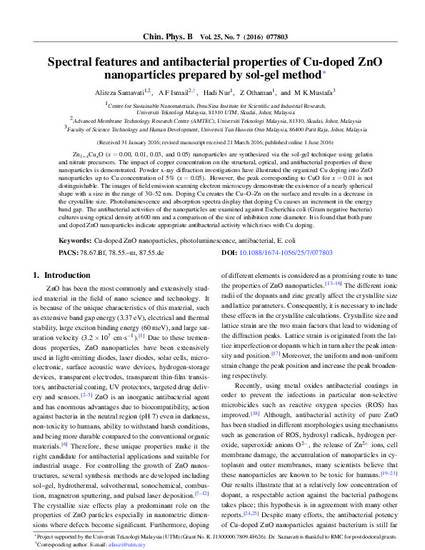
Article
Spectral features and antibacterial properties of Cu-doped ZnO nanoparticles prepared by sol-gel method
Chinese Physics B
(2016)
Abstract
Zn1−xCuxO (x = 0.00, 0.01, 0.03, and 0.05) nanoparticles are synthesized via the sol-gel technique using gelatin and nitrate precursors. The impact of copper concentration on the structural, optical, and antibacterial properties of these nanoparticles is demonstrated. Powder x-ray diffraction investigations have illustrated the organized Cu doping into ZnO nanoparticles up to Cu concentration of 5% (x = 0.05). However, the peak corresponding to CuO for x = 0.01 is not distinguishable. The images of field emission scanning electron microscopy demonstrate the existence of a nearly spherical shape with a size in the range of 30–52 nm. Doping Cu creates the Cu–O–Zn on the surface and results in a decrease in the crystallite size. Photoluminescence and absorption spectra display that doping Cu causes an increment in the energy band gap. The antibacterial activities of the nanoparticles are examined against Escherichia coli (Gram negative bacteria) cultures using optical density at 600 nm and a comparison of the size of inhibition zone diameter. It is found that both pure and doped ZnO nanoparticles indicate appropriate antibacterial activity which rises with Cu doping.
Keywords
- Cu-doped ZnO nanoparticles,
- photoluminescence,
- antibacterial,
- E. coli
Disciplines
Publication Date
2016
DOI
10.1088/1674-1056/25/7/077803
Citation Information
Alireza Samavati, Ahmad Fauzi Ismail, Zulkafli Othaman, Hadi Nur, et al.. "Spectral features and antibacterial properties of Cu-doped ZnO nanoparticles prepared by sol-gel method" Chinese Physics B Vol. 25 Iss. 7 (2016) p. 077803 Available at: http://works.bepress.com/hadi_nur/112/
